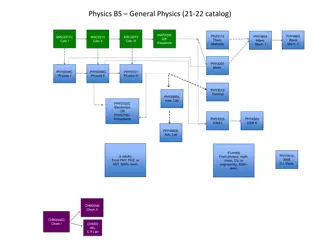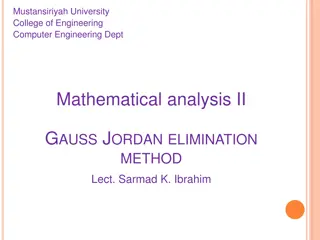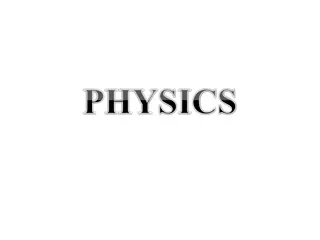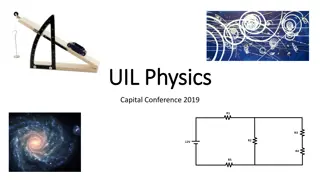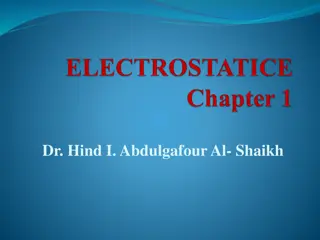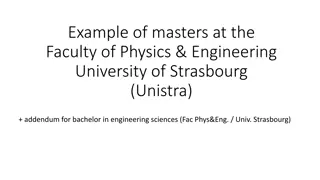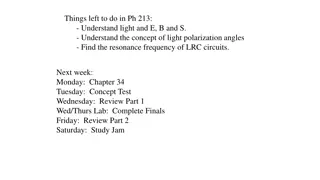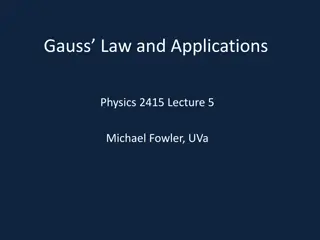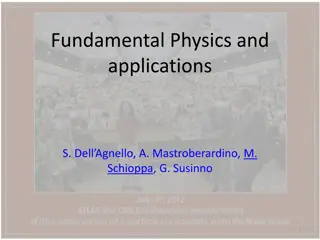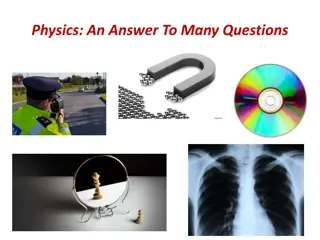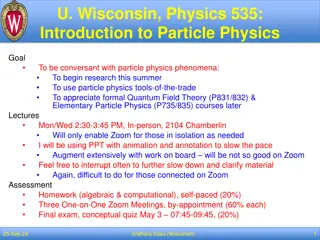Insights on Conductors and Gauss Law in Physics
Explore electric fields in and near conductors, understand Gauss Law, and delve into the behavior of electrons inside a conductor. Discover why there can be no electric field inside a conductor in electrostatics and learn about the distribution of charges on a conductor's surface. Consider scenarios involving the injection of electrons into a metal ball and the presence of trapped charges within insulators, providing insights into electric fields within different materials.
Download Presentation

Please find below an Image/Link to download the presentation.
The content on the website is provided AS IS for your information and personal use only. It may not be sold, licensed, or shared on other websites without obtaining consent from the author. Download presentation by click this link. If you encounter any issues during the download, it is possible that the publisher has removed the file from their server.
E N D
Presentation Transcript
Conductors, Gauss Law Physics 2415 Lecture 4 Michael Fowler, UVa
Todays Topics Electric fields in and near conductors Gauss Law
Electric Field Inside a Conductor If an electric current is flowing down a wire, we now know that it s actually electrons flowing the other way. They lose energy by colliding with impurities and lattice vibrations, but an electric field inside the wire keeps them moving. In electrostatics our current topic charges in conductors don t move, so there can be no electric field inside a conductor in this case.
Clicker Question Suppose somehow a million electrons are injected right at the center of a solid metal (conductor) ball. What happens? A. Nothing they ll just stay at rest there. B. They ll spread throughout the volume of ball so it is uniformly negatively charged. C. They ll all go to the outside surface of the ball, and spread around there.
Clicker Answer Suppose somehow a million electrons are injected into a tiny space at the center of a solid metal (conductor) ball. What happens? They ll all go to the outside surface of the ball, and spread around there. As long as there are charges within the bulk of the ball, there will be an outward pointing electric field inside the ball, which will cause an outward current. (Imagine uniform distribution: Picture the total electric force on one charge from all the others within a sphere centered at the one, this sphere partially outside the conducting sphere.)
Clicker Question A solid conducting metal ball has at its center a ball of insulator, and inside the insulator there resides a completely trapped positive charge. After leaving this system a long time, is there a nonzero electric field inside the solid metal of the conductor? A. Yes B. No a insulator metal charge
Clicker Answer At the instant the charge is introduced, there will be a momentary radial field, negative charges will flow inwards, positives outwards, to settle on the surfaces: There will be nonzero electric field within the insulator, and outside the ball, but not inside the metal. Draw the lines of force! a + + + _ _ __ ____ + + + + +
Electric Field at a Metal Surface A charged metal ball has an electric field at the surface going radially outwards. Any electrostatically charged conductor (meaning no currents are flowing) cannot have an electric field at the surface with a component parallel to the surface, or current would flow in the surface, so The electrostatic field always meets a conducting surface perpendicularly. Note: if there was a tangential field outside and of course none inside you could accelerate an electron indefinitely on a circular path, half inside!
Conducting Ball Put into External Constant Electric Field a The charges on the ball will rearrange, meaning electrons flow to the left, leaving the right positively charged. Note that in the electrostatic situation after the charges stop moving, the electric field lines meet the surfaces at right angles. The sphere is now a dipole!
Field for a Charge Near a Metal Sphere Note: it looks like some field lines cross each other they can t! This is a 3D picture.
Dipole Field Lines in 3D There s an analogy with flow of an incompressible fluid: imagine fluid emerging from a source at the positive charge, draining into a sink at the negative charge. The electric field lines are like stream lines, showing fluid velocity direction at each point. Check out the applets at http://www.falstad.com/vector2de/ !
Velocity Field of a Fluid in 2D example: surface wind vectors on a weather map Imagine a fluid flowing out between two close parallel plates. The fluid velocity vector at any point will point radially outwards. For steady flow, the amount of fluid per second crossing a circle centered at the origin can t depend on the radius of the circle: so if you double the radius, you ll find v down by a factor of 2: 1/ v a r
Velocity Field for a Steady Source in 3D Imagine now you re filling a deep pool, with a hose and its end, deep in the water, is a porous ball so the water flows out equally in all directions. Assume water is incompressible. Now picture the flow through a spherical fishnet, centered on the source, and far smaller than the pool size. Now think of a second spherical net, twice the radius of the first, so 4x the surface area. In steady flow, total water flow across the two spheres is the same: so . This velocity field is identical to the electric field from a positive charge! 2 1/ v r
Flow Through any Surface Suppose now instead of a spherical surface surrounding the source, we take some other shape fishnet. Obviously, in the steady state, the rate of total fluid flow across this surface will be the same that is, equal to the rate fluid is coming from the source. But how do we quantify the fluid flow through such a net? Remember our fluid is incompressible, so it can t be piling up anywhere!
Total Flow through any Surface But how do we quantify the fluid flow through such a net? We do it one fishnet hole at a time: unlike the sphere, the flow velocity is no longer always perpendicular to the area. We represent each fishnet hole by a vector , magnitude equal to its (small) area, direction perpendicular outwards. Flow through hole is The total outward flow is . dA dA v v dA v v dA The component of perp. to the surface is v . v cos net
Gausss Law For incompressible fluid in steady outward flow from a source, the flow rate across any surface enclosing the source is the same. The electric field from a point charge is identical to this fluid velocity field it points outward and goes down as 1/r2. It follows that for the electric field for any surface enclosing the charge (the value for a sphere). 0 const. / E dA Q = = v dA 1 Qr r = E 2 4 0
What about a Closed Surface that Doesn t Include the Charge? The yellow dotted line represents some fixed closed surface (visualize a balloon). Think of the fluid picture: in steady flow, it goes in one side, out the other. The net flow across the surface must be zero it can t pile up inside. By analogy, if the charge is outside. a E dA = 0
What about More than One Charge? Remember the Principle of Superposition: the electric field can always be written as a linear sum of contributions from individual point charges: E E E E = + + + from , , Q Q Q 1 2 3 1 2 3 and so E dA = E dA + E dA + E dA + 1 2 3 will have a contribution from each charge inside the surface this is Gauss s Law. i Q / 0
Gauss Law The integral of the total electric field flux out of a closed surface is equal to the total charge Q inside the surface divided by : 0 Q E dA = 0 S





